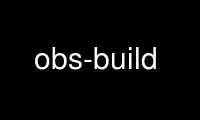
This is the command obs-build that can be run in the OnWorks free hosting provider using one of our multiple free online workstations such as Ubuntu Online, Fedora Online, Windows online emulator or MAC OS online emulator
PROGRAM:
NAME
build - build SuSE Linux RPMs in a chroot environment
SYNOPSIS
build [--clean|--no-init] [--rpms path1:path2:...] [--arch arch1:arch2:...] [--root
buildroot] [specfile|srcrpm]
build --help
build --verify
DESCRIPTION
build is a tool to build SuSE Linux RPMs in a safe and clean way. build will install a
minimal SuSE Linux as build system into some directory and will chroot to this system to
compile the package. This way you don't risk to corrupt your working system (due to a
broken spec file for example), even if the package does not use BuildRoot.
build searches the spec file for a BuildRequires: line; if such a line is found, all the
specified rpms are installed. Otherwise a selection of default packages are used. Note
that build doesn't automatically resolve missing dependencies, so the specified rpms have
to be sufficient for the build.
If a spec file is specified on the command line, build will use this file and all other
files in the directory for building the package. If a srcrpm is specified, build
automatically unpacks it for the build. If neither is given, build will use all the
specfiles in the current directory.
OPTIONS
--clean
remove the build system and reinitialize it from scratch.
--no-init
skip the build system initialization and start with build immediately.
--list-state
list rpms that would be used to create a fresh build root. Does not create the
build root or perform a build.
--rpms path1:path2:path3...
Where build can find the SuSE Linux RPMs needed to create the build system. This
option overrides the BUILD_RPMS environment variable.
--arch arch1:arch2:arch3...
What architectures to select from the RPMs. build automatically sets this to a
sensible value for your host if you don't specify this option.
--repo url_or_dir
Also use the specified repository to create the build system. The repositories may
be either of type rpmmd, yast2 (susetags), or a simple directory. Multiple --repo
options may be given. As a special form, 'zypp://reponame' can be used to specify
a system repository. 'zypp://' selects all enabled system repositories. This is
also the default if BUILD_RPMS is not set and no --rpms or --repo option is used.
--root buildroot
Specifies where the build system is set up. Overrides the BUILD_ROOT enviroment
variable.
--useusedforbuild
Tell build not to do dependency expansion, but to extract the list of packages to
install from "# usedforbuild" lines or, if none are found, from all "BuildRequires"
lines. This option is useful if you want to re-build a package from a srcrpm with
exactly the same packages used for the srcrpm build.
--norootforbuild
--help Print a short help text.
--verify
verify the files in an existing build system.
---dist distribution
Set the distribution. If this option is not given, build tries to calculate the
distribution by looking at the rpm package used in the build. The specified
distribution can either be a string like "11.2" or "sles9", or the pathname of the
build configuration to use.
.spec FILE OPTIONS
The build command interprets some special control comments in the specfile:
# norootforbuild
# needsrootforbuild
build uses either user root or user abuild in the build system to do the build.
For non-SUSE distros as well as since SUSE 10.2, the default build user is abuild.
For 10.2 and before, the default build user is root. These two flags in the spec
file allow to deviate from the defaults and force-set the build user to abuild and
root (for # norootforbuild and # needsrootforbuild respectively.
# needsbinariesforbuild
provide the binary rpms that have been used to set up the build root in
/.build.binaries within the build root.
ENVIRONMENT
BUILD_ROOT
The directory where build should install the chrooted build system.
"/var/tmp/build-root" is used by default.
BUILD_RPMS
Where build can find the SuSE Linux RPMs. build needs them to create the build
system.
BUILD_RPM_BUILD_STAGE
The rpm build stage (-ba, -bb, ...). This is just passed through to rpm, check the
rpm manpage for a complete list and descriptions. "-ba" is the default. You can
use this to add more options to RPM.
Use obs-build online using onworks.net services
